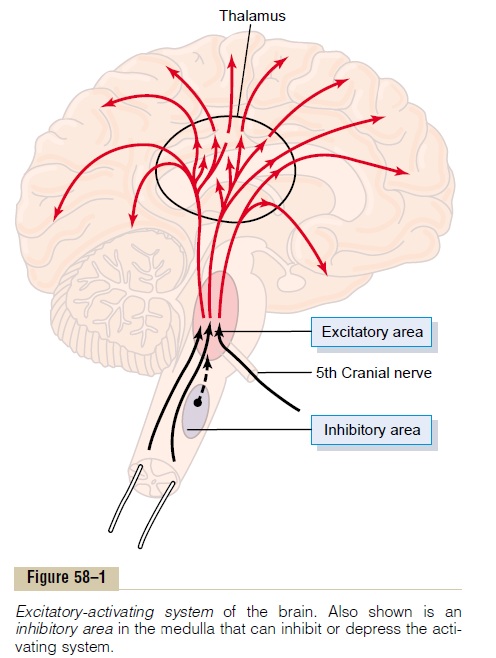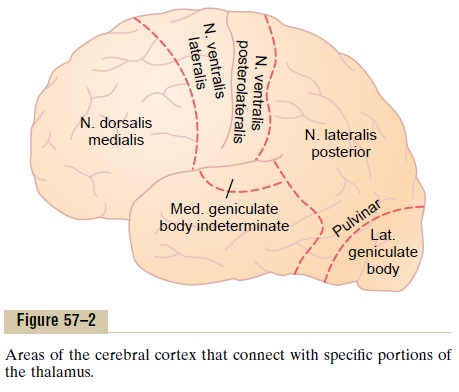Chapter: Medical Physiology: Behavioral and Motivational Mechanisms of the Brain-The Limbic System and the Hypothalamus
Control of Cerebral Activity by Continuous Excitatory Signals from the Brain Stem
Control of Cerebral Activity by Continuous Excitatory Signals from the Brain Stem
Reticular Excitatory Area of the Brain Stem
Figure 58–1 shows a general system for controlling the level of activity of the brain. The central driving component of this system is an excitatory area located in the reticular substance of the pons and mesencephalon. This area is also known by the namebulboreticular facilitory area. We also discuss this because it is the same brain stem reticular area that transmits facilitory signalsdownward to the spinal cord to maintain tone in the antigravity muscles and to control levels of activity of the spinal cord reflexes. In addition to these downward signals, this area also sends a profusion of signals in the upward direc-tion. Most of these go first to the thalamus, where they excite a different set of neurons that transmit nerve signals to all regions of the cerebral cortex as well as to multiple subcortical areas.

The signals passing through the thalamus are of two types. One type is rapidly transmitted action potentials that excite the cerebrum for only a few millisec-onds. These originate from large neuronal cell bodies that lie throughout the brain stem reticular area. Their nerve endings release the neurotransmitter substance acetylcholine, which serves as an excitatory agent, lasting for only a few mil-liseconds before it is destroyed.
The second type of excitatory signal originates from large numbers of small neurons spread throughout the brain stem reticular excitatory area. Again, most of these pass to the thalamus, but this time through small, slowly conducting fibers that synapse mainly in the intralaminar nuclei of the thalamus and in the reticu-lar nuclei over the surface of the thalamus. From here, additional small fibers are distributed everywhere in the cerebral cortex. The excitatory effect caused by this system of fibers can build up progressively for many seconds to a minute or more, which suggests that its signals are especially important for controlling longer-term background excitability level of the brain.
Excitation of the Excitatory Area by Peripheral Sensory Signals.
The level of activity of the excitatory area in the brain stem, and therefore the level of activity of the entire brain, is determined to a great extent by the number and type of sensory signals that enter the brain from the periphery. Pain signals in particular increase activ-ity in this excitatory area and therefore strongly excite the brain to attention.
The importance of sensory signals in activating the excitatory area is demonstrated by the effect of cutting the brain stem above the point where the fifth cerebral nerves enter the pons. These nerves are the highest nerves entering the brain that transmit significant numbers of somatosensory signals into the brain. When all these input sensory signals are gone, the level of activity in the brain excitatory area diminishes abruptly, and the brain proceeds instantly to a state of greatly reduced activity, approaching a permanent state of coma. But when the brain stem is transected below the fifth nerves, which leaves much input ofsensory signals from the facial and oral regions, the coma is averted.
Increased Activity of the Excitatory Area Caused by Feedback Signals Returning from the Cerebral Cortex. Not only doexcitatory signals pass to the cerebral cortex from the bulboreticular excitatory area of the brain stem, but feedback signals also return from the cerebral cortex back to this same area. Therefore, any time the cerebral cortex becomes activated by either brain thought processes or motor processes, signals are sent from the cortex to the brain stem excitatory area, which in turn sends still more excitatory signals to the cortex. This helps to maintain the level of excitation of the cerebral cortex or even to enhance it. This is a general mechanism ofpositive feedback that allows any beginning activity in the cerebral cortex to support still more activity, thus leading to an “awake” mind.
Thalamus Is a Distribution Center That Controls Activity in Spe-cific Regions of the Cortex. As pointed out and shown in Figure 57–2, almost every area of the cerebral cortex connects with its own highly specific area in the thalamus. Therefore, electrical stimulation of a specific point in the thalamus generally activates its own specific small region of the cortex. Further-more, signals regularly reverberate back and forth between the thalamus and the cerebral cortex, the thalamus exciting the cortex and the cortex then re-exciting the thalamus by way of return fibers. It has been suggested that the thinking process establishes long-term memories by activating such back-and-forth reverberation of signals.

Can the thalamus also function to call forth specific memories from the cortex or to activate specific thought processes? Proof of this is still lacking, but the thalamus does have appropriate neuronal circuitry for these purposes.
A Reticular Inhibitory Area Located in the Lower Brain Stem
Figure 58–1 shows still another area that is important in controlling brain activity. This is the reticular inhibitory area, located medially and ventrally in themedulla. We learned that this area can inhibit the reticular facilitory area of the upper brain stem and thereby decrease activity in the superior por-tions of the brain as well. One of the mechanisms for this is to excite serotonergic neurons; these in turn secrete the inhibitory neurohormone serotonin at crucial points in the brain; we will discuss this in more detail later.
Related Topics